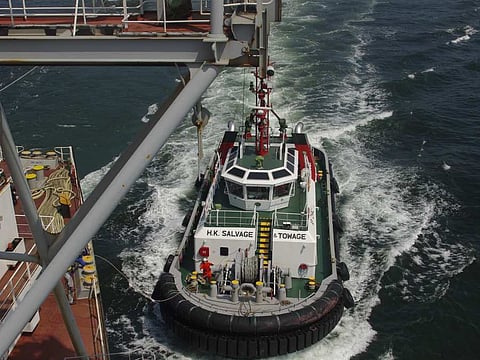

Hard at his labour
Suddenly he reels
Death came behind him
And struck up his heels
– Unknown author
The above rhyme was not found in a Christmas cracker, but can be seen on a gravestone in the village of my birth.
The poor unfortunate interred there was not, sadly, named Achilles, but died when he was charged by an angry ram while he was shearing his sheep. I suspect the "heels" in the rhyme actually refers to an area at the other end of his legs, but you can't carve "buttocks" on a headstone.
People have been shearing sheep in my village since well before the Norman conquest, yet this is the only recorded case I can find of a death resulting from the annual woolfest. Nowadays, I expect the farmers have to fill in a safety checklist, conduct a formal risk assessment, and hold a toolbox talk before they pick up their shears, so we may never see another memorial to the victim of a killer sheep.
I was reminded of that unfortunate chap when I read a recent report about the British Tugowners Association (BTA) annual safety seminar, where it was stated that reducing incidents of towing line failures, poorly connected pilot ladders, and illegally weighted heaving lines will be the focus of the British towing industry going forward. Alarmingly, there have been increasing incidents of ships throwing down heaving lines with dangerously heavy weights attached. Kalvin Baugh of the Maritime and Coastguard Agency (MCA) revealed that they have recorded an average of 4.7 incidents per month over the past 31 months.
Assuming the MCA is only collating data from UK ports, this is a truly frightening number and implies that British tug crews are being exposed to dangers that are entirely avoidable. It also raises questions about the intelligence of the people throwing such projectiles. Sheep are animals that cannot think for themselves, but there are crewmembers out there who make these animals look positively intelligent. What on earth would make anyone think it was a good idea to throw a heavy lump of metal anywhere near human beings working below?
Fortunately, there are things we can do about it. Several tug companies now have a policy of cutting off offending weights and replacing them with approved rubber projectiles. It costs a few dollars, but it might save lives and might even cause the individuals throwing the things to question their actions (although, given the levels of ignorance involved, this may be a forlorn hope).
When I raised the topic with my former colleagues in Hong Kong, they claimed to be seeing fewer cases since they started taking action to educate the seafarers involved in homicidal heaving line practices. This education takes the form of refusing to make fast if anyone aboard the tug sees a dangerous projectile being waved in their direction, and explaining to agents that the tug crews will refuse to work with offending vessels unless those on board stop trying to kill them. They even conducted a trial where they painted a target on the forecastle deck and invited crews to land their projectiles within the target whilst the deckhand took cover in an entirely different part of the tug. This was not entirely successful because nobody could hit the target and the deckhand would probably have been safer standing within the target area.
Turning to the other areas the BTA members will focus upon, I have no sympathy for companies that suffer repeated towing line failures. We are supposed to be professionals, and knowing how to preserve a towing line and when to replace it are basic professional skills. Of course, there are always going to be extraordinary circumstances where a towing line parts, but these should be few and far between.
Improperly rigged pilot ladders are a different matter. Rigging them is not difficult yet we see dozens of cases where lives are put at risk because crews cannot master the simple steps involved. Presumably, these are the same crews who throw deadly projectiles at our tugs, and you have to wonder what has gone wrong with STCW training if such practices are so widespread. It is heartening to know that many more ports are refusing to let pilots board if the ladder is not properly rigged. Owners and managers whose ships are delayed because the pilot refuses to board are much more likely to take action and get it right in the future.
Hitting offenders in the pocket is likely to be the most effective way of reducing dangers that can so easily be mitigated. Recent studies have shown that companies with a robust safety culture and "kind leadership" are more profitable and find it easier to retain staff, so there is no excuse for ignoring safety. It certainly will not save money.
It strikes me that this is a column that should not be necessary, but until all our colleagues at sea have at least the IQ of a sheep, we live in perilous times. Stay safe.
